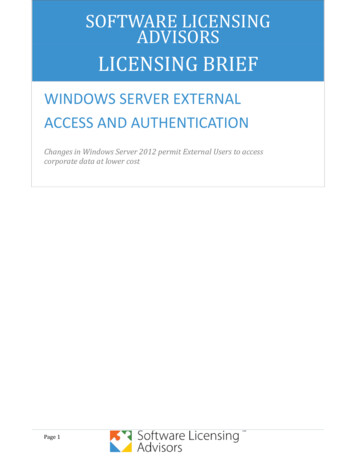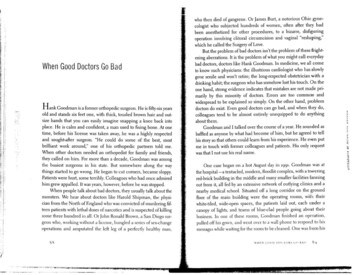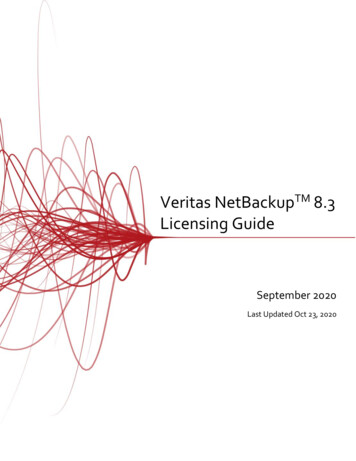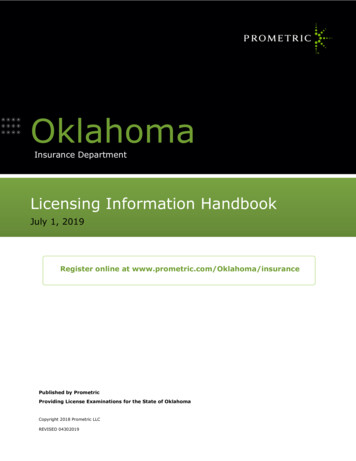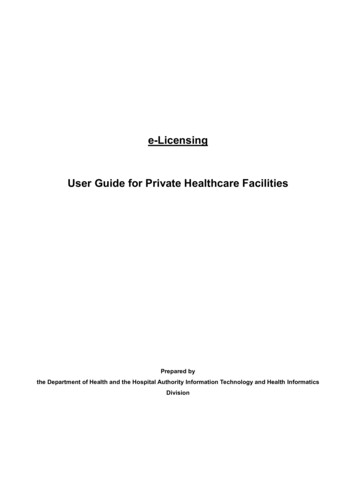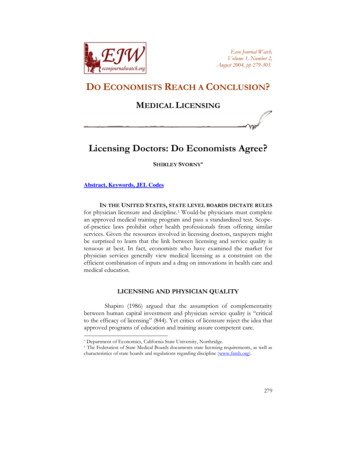
Transcription
Econ Journal Watch,Volume 1, Number 2,August 2004, pp 279-305.DO ECONOMISTS REACH A CONCLUSION?MEDICAL LICENSINGLicensing Doctors: Do Economists Agree?SHIRLEY SVORNY*Abstract, Keywords, JEL CodesIN THE UNITED STATES, STATE LEVEL BOARDS DICTATE RULESfor physician licensure and discipline.1 Would-be physicians must completean approved medical training program and pass a standardized test. Scopeof-practice laws prohibit other health professionals from offering similarservices. Given the resources involved in licensing doctors, taxpayers mightbe surprised to learn that the link between licensing and service quality istenuous at best. In fact, economists who have examined the market forphysician services generally view medical licensing as a constraint on theefficient combination of inputs and a drag on innovations in health care andmedical education.LICENSING AND PHYSICIAN QUALITYShapiro (1986) argued that the assumption of complementaritybetween human capital investment and physician service quality is “criticalto the efficacy of licensing” (844). Yet critics of licensure reject the idea thatapproved programs of education and training assure competent care.Department of Economics, California State University, Northridge.The Federation of State Medical Boards documents state licensing requirements, as well ascharacteristics of state boards and regulations regarding discipline (www.fsmb.org).*1279
SHIRLEY SVORNYCurrently the process for ensuring physician quality relieswholly on graduation from an approved medical schooland the passing of a licensing examination . . . noreexamination is required. . . . State licensing boards areresponsible for monitoring physicians’ behavior. . . .Unfortunately, this approach for assuring physician qualityand competence is completely inadequate. (Feldstein 1994,189)Licensure does not restrict physicians to practice in aparticular area of medicine. (In the United States, it is notagainst the law for an ophthalmologist to perform heartsurgery.) Furthermore it is hard to argue that passing astandardized exam . . . offers much information aboutphysician competence or success. (Svorny 2000, 303)licensing laws supported by the AMA left physicians freeto practice medicine according to any system oftherapeutics they chose once they had obtained a license topractice. (Goodman 1980, 7)consumers were (and still are) not as well protected fromunqualified and unethical practitioners as they have beenled to believe. (Feldstein 1999, 395)It is hard to argue that quality care is the objective as, in many cases,licensing laws exclude individuals for reasons unrelated to their professionalcompetence.Residency requirements for foreign-trained physicians . . .continue to exceed the requirements for graduates of U.S.medical schools. (Seldon, et al. 1998, 820)Researchers question whether state medical boards effectivelyoversee medical professionals.few resources have been devoted to monitoring the qualityof practice after an individual has been licensed.Applicants to medical school are given close scrutiny. TheECON JOURNAL WATCH280
MEDICAL LICENSINGbudgets for the state medical boards suggest that thelicensed practitioners are not. (Benham 1991, 81)In the United States, state license revocation efforts havebeen subject to criticism for avoiding (admittedly difficult)issues of physician competence and for focusing, instead,on physicians who prescribe narcotics inappropriately toothers or who abuse drugs and/or alcohol themselves.(Svorny 1992, 32)Medical boards in many states do not even specifyincompetence as grounds for disciplinary action. (Gaumer1984, 398)To many, it is clear that the current system of regulation does notassure quality care.Though no one is suggesting that eliminating licensure andother requirements will reduce . . . negative outcomes, it isclear that regulation does not assure quality care. (Folland,Goodman, and Stano 2001, 358)The available research does not suggest that existingsystems of regulation have effectively controlled initial orsubsequent competency of professionals. (Gaumer 1984,406)[There is evidence that mandatory programs of continuingeducation are] burdensome and fruitless. (Gaumer 1984,399)The performance of the medical profession, state regulatoryagencies, and the malpractice system in protecting patientsagainst negligent physicians has been inadequate.(Feldstein 1999, 397)An important point is that, perversely, licensing can reduce thequantity and quality of health care.281VOLUME 1, NUMBER 2, AUGUST 2004
SHIRLEY SVORNYRestrictive licensing can . . . result in declines in the qualityof received services in that there may be (1) selfsubstitution of inferior products and/or services . . . ; (2)decreases in the average per capita service time rendered;for example, short, hurried, delayed office visits with aharried physicians; (3) differential geographic availability asnumbers are reduced and the remaining members of theprofession can choose their locations with more discretion,such as doctor shortages in rural areas; and (4) increasedwaiting time for provision of a service where delay inservice entails expense for the buyers. (Carroll and Gaston1979, 2)The existing system results in some persons receiving nocare, or being treated by individuals without any medicaltraining (family members, neighbors, friends). (Fuchs 1986,19)Kugler and Sauer (2004) suggest the high costs of obtaining a licensemay deter talented individuals from pursuing state approval to practice,reducing physician service quality. Examining the earnings of immigrantphysicians in Israel, they find a negative selection bias due to the cost of relicensing. By negative selection, they mean, “immigrant physicians whoacquire a license have lower intrinsic earnings potential (in the absence of alicense) than those who do not” (Kugler and Sauer 2004, 5).Benham (1991) pointed to yet another way in which licensingrestrictions reduce service quality.a clear consequence of licensure is to inhibit the productionof information concerning the comparative performanceof practitioners and hospitals. This in turn reduces theincentive to introduce innovations that would facilitatecomparative evaluations and improve quality control.(Benham 1991, 89-90)Phelps (1997) does not share this view. He sees licensure as a“guarantee” of minimum quality that may increase the production ofinformation.ECON JOURNAL WATCH282
MEDICAL LICENSINGOn net, one cannot say that licensure is necessarily abenefit or a harm to consumers. The potential gains inquality information may outweigh any costs frommonopolization. Indeed, it may even be that the marketoperates more competitively because the “minimumquality” guarantee that licensure produces may increaseconsumer willingness to search for lower prices. (Phelps1977, 243)Of course, such a “guarantee” might result from certification ratherthan licensure. The relative merits of the two schemes are discussed below.COMMENTS ON THE EFFICIENT PRODUCTIONOF PHYSICIAN SERVICESA concern is that physician licensure limits innovation in medicalmarkets and flexibility in hospital and other institutional staffing.On innovationI am persuaded that licensure has . . . retarded technologicaldevelopment both in medicine itself and in theorganization of medical practice. (Friedman 1962, 158)it must be kept in mind that the various licensure laws . . .have rarely been designed to keep up with the rapidlychanging organizational and technical innovations that arepotentially feasible in health-care delivery. The preponderant view—certainly among health economists—is thatphysicians have not even begun to exploit the productivitypotential actually within their reach. (Reinhardt 1975,231, 233)Medical licensure has had a deleterious effect on thequality of medical care by sharply reducing heterogeneityin the practice of medicine. . . . Even in those areas283VOLUME 1, NUMBER 2, AUGUST 2004
SHIRLEY SVORNYwhere promising innovations have arisen, medicallicensure laws have restricted, or threatened to restrict,their application. (Goodman 1980, 36)It is my view that economists have concentratedexcessively on the indirect effects of barriers to entryand too little on such issues as restrictions oninnovation, excessive training requirements. (Benham1980, 24)On scope-of-practice limitationsIt is now widely accepted that more extensive taskdelegation in medical practice would be in society’sinterest. . . . Constraints widely believed to inhibit moreefficient use of health manpower are the various licensurelaws governing the practice of medicine in this country.(Reinhardt 1975, 229, 231)Many studies . . . show that the quality of care would notsuffer if licensure policies were selectively liberalizedallowing mid-level practitioners to perform some tasks notreserved only for . . . physicians. (Gaumer 1984, 397)Scope-of-practice rules limit medical professionals’ career mobility(Gaumer 1984). Licensing statutes preclude the informal transitions thatoccur in other industries as individuals gain expertise over time.On inefficient training requirementsThe American Medical Association has the power tocontrol the costs of medical training as well as the numberobtaining that training. By making it more costly tobecome a physician . . . the profession may insure that allincomes rise while the expected returns “at the margin”remain normal. The profession, in other words, isinfluenced to make medical education as inefficient aspossible. (Lindsay 1973, 346)ECON JOURNAL WATCH284
MEDICAL LICENSINGlicensing can cause applicants to overinvest in educationand formal training. . . . If these attributes do not improveproductivity the investments are wasted socially. (Dorsey1980, 433)GENERAL AGREEMENT THAT LICENSINGENFORCES CARTEL BEHAVIORSEconomists see state licensing as a source of cartel power amongphysician groups. Kessel (1958 and 1970) pointed out that licensingrequirements increase returns for existing practitioners at consumers’expense. He was especially concerned that graduation from an AmericanMedical Association-approved medical school was a condition foradmission to state licensing exams—allowing organized medicine to controlentry to the very market it served (1958, 283).Folland, Goodman, and Stano (2001) note that “organized medicinehistorically exerted considerable influence over the supply of trainedphysicians” (354). Given more recent empirical evidence, however, theyexpress doubt about the continued role of medical professionals in limitingmedical school enrollment.data in recent decades indicate that medical schoolenrollments are responsive to market forces . . . continuingto view medical education as controlled by a monolithic orconspiratorial medical profession is somewhat implausible.(Folland, Goodman, and Stano 2001, 354)Still, they write of:the questionable effects of licensure on quality and theanticompetitive effects of restrictions on entry andrestrictions on the scope of practice of potentialcompetitors. (Folland, Goodman, and Stano 2001, 358)Zweifel (1991) listed several factors that favor medical groups (overother professions) in acting as a cartel. Except perhaps for elective surgeries285VOLUME 1, NUMBER 2, AUGUST 2004
SHIRLEY SVORNYon the wealthiest clients, medicine is characterized by a lack of internationalcompetition for its product. Also, what is sold is a personal service thatcannot be resold, making it difficult to undermine price discrimination.Finally, licensure allows control of market entry.The view that licensure facilitates cartel-like behavior has beenexpressed over and over.[organized medicine] has, for over 100 years, sought andobtained special privileges from government. These specialprivileges take the form of restrictions on free competitionin the marketplace. (Young 1987, 2)In granting sole authority to the boards to issue licenses,society has, in effect, given considerable power toorganized medicine to restrict the supply of physicians andto influence the pattern of medical care for the benefit ofthe profession. (Rayack 1982, 393)The ability of the profession to influence medical schooladmissions and licensure exams, as well as their resistanceto legal delegation of more routine tasks to other healthprofessionals, has certainly helped perpetuate theireconomic advantage. (Burstein and Cromwell 1985, 77)The establishment of limits on the use of physicianextenders is yet another method physicians employ toprotect their economic interests. (Santerre and Neun 2000,423)Economists have, for some time, suspected that occupationallicensure operates as a legally sanctioned cartelizationdevice, restricting entry . . . and restraining competition. . . .Excessive limits . . . can result in monopoly rents formembers of the profession and higher prices and fewerservices for consumers. (Martin 1980, 143-144)The AMA has not only controlled the supply of medicalschool spaces in the United States . . . but also has workedto assure that state licensing statutes require graduationfrom AMA-accredited schools. Foreign entry has also beenECON JOURNAL WATCH286
MEDICAL LICENSINGcurtailed by restrictive licensing laws as well as a strictfederal immigration policy. (Noether 1986, 233)coupled with findings that consumers are rarely, if ever,involved in the process, and that the resulting regulationsdo in fact raise prices and decrease the availability ofservices, the evidence supporting the self-interest model ofregulation is substantial. (Begun, Crowe, and Feldman1981, 250)The emphasis in terms of quality is always on the trainingof entering physicians and not on those currently practicingin the profession. It is in the economic interests of currentpractitioners . . . they will receive higher prices and higherincomes. . . . If the medical profession was concernedprimarily with quality rather than with monopoly power,there would be at least some emphasis by the professionon the quality of care provided by practicing physicians.(Feldstein 1999, 383, 386)By the 1950’s, organized medicine had achieved virtuallyall of its political goals . . . [one of which was] to controlentry into the medical profession and to suppresscompetition for physicians’ services. . . . The most importantconsequence of the control of medical education byorganized medicine . . . was that physicians acquired thepower to reduce the supply of medical services andincrease their incomes. (Goodman and Musgrave 1992,137, 147).As time passed, restrictions were expanded tocover . . . advertising, price cutting, and other conductconsidered to be “unprofessional.” Clearly licensing lawsserve not only to protect patients but also to limit thenumber of practitioners, thus protecting physicians fromwould-be competitors. (Henderson 2002, 107)The [American Medical Association] has been . . . vigorousin attacking health practitioners who are widely considered287VOLUME 1, NUMBER 2, AUGUST 2004
SHIRLEY SVORNYlegitimate but who represent a competitive threat to themembers of the medical profession. (Rayack 1982, 405)Mainstream physicians benefit from a more restrictiveregulatory regime governing practitioners of alternativetherapies. . . . Licensing laws that reduce the supply of suchalternative services harm consumers by rendering such lowcost options unavailable while these laws also appear tocreate rents for mainstream physicians. (Anderson, et al.,2000, 497)the medical profession as a whole must ultimately bearresponsibility for the nature of these laws and their effecton resource allocation within the health-care sector.(Reinhardt 1975, 232)Of course, given the nature of the political system in the UnitedStates, it is likely that both consumer and physician interests influenceregulatory outcomes. In empirical tests, Leffler (1978) found that variationsin licensing laws across states could be explained by consumer demand forquality. However, two studies that examined the relative influence ofphysicians and consumers found that physician interests dominateregulatory outcomes.on the margin, the licensure restrictions in practice in 1965increased entry costs by more than they reducedconsumers’ costs of generating quality assurance in themarket for physician services. . . . The implication is thatprofessional or special interests dominated consumerinterests in the setting of licensure requirements. (Svorny1987, 507)[With respect to the regulation of certified nurse midwives]. . . supply-side (quantity reducing) effects dominate thedemand-side (quality assurance and quantity enhancement)effects . . . it appears that regulation of this type of servicehas detrimental consumer welfare effects. In a time whenmany medical service delivery systems are in chaos, theadvantages to deregulation of such fundamental activitiesshould not be minimized. (Adams, et al. 2003, 673)ECON JOURNAL WATCH288
MEDICAL LICENSINGThe continued influence of the American Medical Association isattributed to effective lobbying and few challenges from consumers. MiltonFriedman wrote:The groups that think they have a special interest . . . areconcentrated groups to whom the issue makes a great dealof difference. The public interest is widely dispersed. Inconsequence . . . producer groups will invariably have amuch stronger influence . . . [than the] widely spreadconsumer interest. (Friedman 1962, 143)Weingast (1980), alone, takes exception to the idea that physicianinterests will dominate the political decision-making process.While the producers probably have superior organization,once the issue enters election campaigns, furthercoordination by the diffuse nonproducers is not needed:all they need to do is vote. (Weingast 1980, 90)However, if it is costly to assess the likely vote of each candidate onevery issue, nonproducers may face higher costs of influencing outcomes,bringing us back to the more commonly held belief that professional groupsare likely to dominate public policy.DO INFORMATION ASYMMETRIESJUSTIFY LICENSING DOCTORS?Some economists take the position that information asymmetriesjustify government intervention in medical labor markets. As Evans puts it,the essence of the professional relationship is that theconsumer does not know what he needs before service,nor does he know afterward whether he was adequatelyserved. (Evans 1980, 250)289VOLUME 1, NUMBER 2, AUGUST 2004
SHIRLEY SVORNYThe counter position is that word-of-mouth and physician referralsprovide guidance, as do other mechanisms, such as institutional reputation.people do not . . . choose physicians by picking names atrandom from a list of licensed physicians. (Friedman 1962,158)even in many situations labeled ‘emergency’ the consumerhas in principle a considerable amount of power over whatcan be done to him (including whether or not he choosesto be an ‘emergency’ case) and which physician he choosesin order to obtain advice. (Pauly 1980, 43)Since a consumer has generally recognized the existence ofa problem, he can presumably recognize its dimunition.This ability to evaluate quality ex post, even if the evaluationis only approximate, provides checks on low-quality sellers,through both liability laws and the consumer’s ability toshop elsewhere if quality is poor. (Beales 1980, 128)EXAMINING THE EXCEPTIONSArrow’s 1963 paper on medical care is frequently cited in supportof physician licensure.The general uncertainty about the prospects of medicaltreatment is socially handled by rigid entry requirements.These are designed to reduce the uncertainty in the mindof the consumer as to the quality of product insofar as thisis possible. I think this explanation, which is perhaps thenaïve one, is much more tenable than any idea of amonopoly seeking to increase incomes. No doubtrestriction on entry is desirable from the point of view ofthe existing physicians, but the public pressure needed toachieve the restriction must come from deeper causes.(Arrow 1963, 966)ECON JOURNAL WATCH290
MEDICAL LICENSINGHowever, in a footnote, Arrow acknowledged the difficulty ofassuring quality though the regulatory licensing of professionals. As to theability of licensing to reduce uncertainty about quality, he wrote:How well they achieve this end is another matter. R.Kessel points out to me that they merely guaranteetraining, not continued good performance as medicaltechnology changes. (Arrow 1963, 966)In addition, Arrow expressed a number of other concerns about statelicensing.Both the licensing laws and the standards of medicalschool training have limited the possibilities of alternativequalities of medical care . . . [that might] appeal to differenttastes and incomes. (Arrow 1963, 953).[restrictions on entry to the field have] constituted a directand unsubtle restriction on the supply of medical care.(Arrow 1963, 955)The licensing laws . . . exclude all others from engaging inany one of the activities known as medical practice. As aresult, costly physician time may be employed at specifictasks for which only a small fraction of their training isneeded, and which could be performed by others less welltrained and therefore less expensive. (Arrow 1963, 957)the present all-or-nothing approach could be criticized asbeing insufficient with regard to complicated specialisttreatment, as well as excessive with regard to minormedical skills. (Arrow 1963, 967)Despite how often it is cited in favor of physician licensing, Arrow’sarticle offers little to public policy makers trying to decide if licensing makessense. He catalogs the ways in which health care markets depart fromperfect competition and presumes that some sort of governmentintervention would improve upon a market outcome. He hedges thisconclusion with numerous comments on the inefficiencies of licensing291VOLUME 1, NUMBER 2, AUGUST 2004
SHIRLEY SVORNYregulations in the United States. Arrow does not make a clear case for oragainst licensing doctors.Weingast (1980) who, like Arrow, asserts that informationasymmetries are a problem for consumers of health care, argued that statelicensure is not the solution. He wrote: “[the] political solution to themarket inadequacies fails for precisely the same reason the market failed inthe first place—the informational asymmetries” (93).In their 1989 paper, Graddy and Nichol express the belief thatinformation asymmetries present in health care markets require somedegree of regulation. Like Weingast, they do not support licensure as itexists.Consumers should be protected from incompetentproviders, but should otherwise be able to choose amongdifferent price/quality options which may satisfy individualpreferences. (Graddy and Nichol 1989, 614)Graddy and Nichol do not specify the ways in which they wouldrevise existing licensing statutes to increase choice in medical markets, butother economists, quoted below, have some ideas.LICENSURE VS. CERTIFICATIONMany economists prefer certification to licensure.Under certification buyers have a wider range of choices . . .they can buy low-quality goods or services if they wish.(Leland 1980, 283)The case for licensure presumably rests on the propositionthat the consumer is a poor judge of the quality of medicalcare and therefore needs guidance. . . . Assuming this to betrue, the need for guidance could be met by voluntarycertification rather than compulsory licensure. . . . Under acertification system patients would be free to choose thelevel of expertise that they wanted, including uncertifiedpractitioners. (Fuchs 1986, 19)ECON JOURNAL WATCH292
MEDICAL LICENSINGAs long as certified personnel are available, economicmodels suggest consumers will not gain as a result ofreplacing certification with mandatory licensure unlessthere are some sort of problems with market failure whichgo beyond difficulties simply in identifying qualifiedpersonnel. (White 1987, 32)Even if entry controls do improve quality, that improvementcan be purchased far more cheaply via certification ofprofessionals, rather than through licensing. Consumerswould then be able to choose between high-quality, highpriced services and lower quality at a lower price. (Beales1980, 140)The efficiency case for licensing can be made only underrestrictive conditions—when market failure cannot beremedied by private exchange (such as by certification andadvertising) as costlessly as it can be remedied by governmentidentification and the outlawing of incompetent and unscrupulous practitioners. No study has yet been producedby the economics profession that makes a case, on costbenefit grounds, for the licensing of any profession. (Elzinga1980, 114)Two arguments for licensure over certification carry little weight witheconomists. The first is that consumers need the government to makedecisions for them. This does not go over well, as most economistsrecognize that the government can not begin to speak for the tastes andpreferences of millions of individuals—the private market allows theexpression of those tastes and preferences. It is this variation in tastes, infact, that generally leads economists to favor a system of registration orcertification, under which consumers make choices for themselves.A second argument in support of licensure over certification is thatthere are externalities associated with the consumption of low qualityphysician services (Moore 1961). The issue here is that, if a consumerpurchases incompetent care and a contagious disease is misdiagnosed,others will suffer. In the United States, however, a bigger problem appearsto be people who do not purchase care at all. Eliminating licensure would293VOLUME 1, NUMBER 2, AUGUST 2004
SHIRLEY SVORNYmake care cheaper and more available, encouraging many of those who donot currently seek care to do so.A final justification for licensure over certification suggests thatlicensure reduces agency costs in the market for physician services. Byrestricting entry and, therefore, increasing the profitability of medicalpractice, licensure creates incentives for physicians to act with the bestinterests of their patients in mind. With greater profitability, physicians havemore to lose if they engage in malfeasance. This efficiency wage argumentfor licensure over certification is outlined by Svorny (1987). The incentiveeffects of a loss upon malfeasance have been mentioned elsewhere.licensing may serve to protect consumers . . . by providingan asset, namely the license itself, that may be seized in theevent of negligent performance. (Shapiro 1986, 861)As one would expect, the more ethical wealth that onemust forego as a result of being discovered reducingquality, the less likely is the reduction in quality. (Blair andKaserman 1980, 194)However, no one has yet made the case that information costs aresufficiently high enough to justify the inefficiencies associated with governmentintervention over those of the market.PROPOSALS FOR CHANGEAs the above discussion indicates, at the least, economists favorreducing the power of the American Medical Association over statelicensure. In that vein, Rayack argues to replace profession dominatedlicensure boards by “responsible administrative agencies.” 2The social acceptance of licensing in medicine indicates ageneral belief in the desirability of providing protection ofThe economics literature on regulatory capture suggests that shifting power from the AMAto administrative agencies reporting to state legislatures would continue to leave the processsubject to AMA influence.2ECON JOURNAL WATCH294
MEDICAL LICENSINGthe consumer through the maintenance of standards. . .[amoderate] approach is possible whereby AMA power canbe curbed and at the same time socially acceptable medicalstandards can be maintained. (Rayack 1982, 425)Also, to reduce the influence of medical professionals, Blair and Kasermansuggest separating the functions of the board into regulating product qualityand regulating competition.in situations requiring self-regulation by members of theprofession . . . the attainment of a socially optimum outcomemay require the existence of more than one regulatorybody with a separation of goals: self-regulation of productquality with external regulation of competitive practices.(Blair and Kaserman 1980, 197)Gaumer (1984) advocates “reforms of the exclusionary and selfserving aspects of credentialing” (410) by means of changes in administrativeprocesses and practice constraints. He expressed support for efforts togroup related health professionals together on state boards to internalize“state manpower planning concerns, interoccupational conflicts, and servicedelivery productivity losses” (409).Also to reduce the influence of physicians over licensing decisions,Svorny and Toma (1998) suggest shifting the source of state medical boardfunding away from physician fees to the state legislature. Controlling forother factors, they find that the influence of physicians over board actionsis less in states where boards are funded by the state legislature.295VOLUME 1, NUMBER 2, AUGUST 2004
SHIRLEY SVORNYFeldstein proposed “specific-purpose licensure.”Specific-purpose licensure would mean that not allphysicians would need to take the same educationaltraining, training in some specialties would take a muchshorter period of time. . .When a physician wants anadditional specific-purpose license, he or she could receiveadditional training and then take the qualifying exam forthat license. The training requirements for entering themedical profession would be determined not by themedical profession, but by the demand for different typesof physicians and the least-cost manner of producingthem. (Feldstein 1994, 190-191)In the third edition of his health economics textbook, Feldstein(1999) refers to this as “task” licensure, making the point that licensingphysicians to perform specific tasks would lower the cost of a medicaleducation (396).Even Evans (1980), who advocated “an extensive regulatory web . . .to constrain the [health care] industry” (263) opposed
(Reinhardt 1975, 229, 231) Many studies . . . show that the quality of care would not suffer if licensure policies were selectively liberalized allowing mid-level practitioners to perform some tasks not reserved only for . . . physicians. (Gaumer 1984, 397) Scope-of-practice rules limit medical professionals' career mobility (Gaumer 1984).

